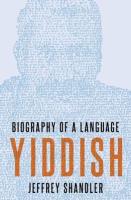Description
Jeffrey Shandler tells the multifaceted history of Yiddish in the form of a biographical profile, revealing surprising insights through a series of thematic chapters. He addresses key aspects of Yiddish as the language of a diasporic population, whose speakers have always used more than one language. As the vernacular of a marginalized minority, Yiddish has often been held in low regard compared to other languages, and its legitimacy as a language has been questioned. But some devoted Yiddish speakers have championed the language as embodying the essence of Jewish culture and a defining feature of a Jewish national identity. Despite predictions of the demise of Yiddish-dating back well before half of its speakers were murdered during the Holocaust-the language leads a vibrant, evolving life to this day.
Product Details
- Oxford University Press, Brand
- Oct 19, 2020 Pub Date:
- 9780190651961 ISBN-13:
- 0190651962 ISBN-10:
- 264 Pages
- English Language
- 9.3 in * 6.3 in * 1 in Dimensions:
- 1 lb Weight:




